What happens when the birds in the forests disappear? Scientists confirm serious consequences for forest functioning
In a groundbreaking study led by Katerina Sam from Biology Centre of Czech Academy of Sciences and University of South Bohemia, the team of researchers delved into the intricate dynamics of flying vertebrate predators and ants, unravelling their impact on arthropod densities and herbivory along the elevational gradient of Mt. Wilhelm, Papua New Guinea.
In the photo the Papuan frogmouth (Podargus papuensis). Photo: BC CAS
“Throughout our investigation,” Katerina Sam noted, “we observed a very surprising and consistently strong impact of flying vertebrate predators on arthropod densities across the entire elevational range. The removal of insectivorous vertebrate predators led to a substantial increase (by 40-60%! in 6 months) in arthropod populations, which in turn could have significant repercussions for the ecosystem.”
Elise Sivault, a PhD student from University of South Bohemia and Biology Centre of Czech Academy of Sciences, who focused on the study of bats, revealed: “The abundance of insectivorous bats was particularly high at low elevations and then at 2700 m a.s.l., while insectivorous birds peaked in their densities at mid-elevations (1700 and 2200 m a.s.l.). This difference in distribution sheds light on the varying roles of birds and bats in shaping predator-prey interactions.” “However, as pointed above, the overall impact of both predator groups combined, remained rather consistent across the whole mountain range,” adds Pita Amick, another PhD student who conducted the research of bat communities.
The statistical analysis, expertly conducted by Leonardo Re Jorge from Biology Centre, reinforced the team's findings. “Our results indicated a clear correlation between predation risk on arthropods and the abundance of predatory birds, providing further support for the hypothesis that predator density drives the effects of predation on lower trophic levels.”
The scientists further investigate the impact of the disappearance of predators on arthropod body sizes and found that arthropods collected from the caged treatments (i.e., where the absence of predators was mimicked and where vertebrate predators had no access), were significantly larger compared to arthropods collected from control. Notably, larger arthropods, exceeding approximately 2.2 cm in length, were exclusively found in the caged treatments, emphasizing the influence of vertebrate predators on arthropod size distribution. Large insect of course eats larger amounts of plant biomass (i.e., causing larger herbivory damage), which further affects the plant growth and productivity.
While the absence of vertebrate insectivores resulted in a considerable increase in arthropod densities, Katerina Sam pointed out: "The exclusion of ants did not have a significant effect on arthropod communities, highlighting the nuanced nature of predator-prey relationships within the ecosystem."
Furthermore, the research revealed intriguing patterns in herbivory damage on plants. “Contrary to our initial expectations,” Katerina Sam explained, “the effect of predator exclusion on herbivory increased not between 700 and 1700 m a.s.l. where we expected that earlier due to highest densities of birds, but actually at the lowest and highest elevations. This is a very interesting result which might be driven by plant defence mechanisms, interplaying with the impact of predators. Seasonal variations also played a key role in influencing herbivory rates, especially during the wet season when herbivory damage increased notably in productive lowland sites.” In the dry season, the effect was hard to detect.
In conclusion, this comprehensive study led by Katerina Sam and her team sheds new light on the intricate interactions between flying vertebrate predators, ants, arthropods, and plants. The nuanced findings underscore the site-specific nature of these relationships and emphasize the need for further research to comprehend the complexities that govern tropical ecosystems.
In this epic scientific journey, the researchers used an experimental approach which was rather unique. “We excluded vertebrate predators and ants from 560 saplings in two 6-month-long predator exclusion experiments, controlling for seasonality. Saplings were spread across eight sites, evenly spaced at 500 m elevational increments from 200 to 3700 m a.s.l. For the study, we needed 9km of PVC pipes to construct the cages, and netting which would cover 2.2 football fields. We had to carry everything in hands, along very bad roads, and construct the cages at sites,” reminds Bonny Koane, an ornithologist and researcher from Binatang Research Centre from Papua New Guinea.
Elise Sivault emphasizes: “Preserving these delicate balances becomes imperative for safeguarding the ecological integrity of our planet's rich biodiversity.” The findings are important for conservation efforts, as some insectivorous predators are very sensitive to habitat disturbances, and here the scientists quantify what would happen if they disappear. Despite the scientists from the Laboratory of multitrophic interactions, led by Katerina Sam, simulated only full disappearance of the insectivorous predators, the results indicate that even their partial disappearance would disturb the functioning of the forests significantly.
 Original work:
Original work:
Sam, K., Jorge, L. R., Koane, B., Amick, P. K., & Sivault, E. (2023). Vertebrates, but not ants, protect rainforest from herbivorous insects across elevations in Papua New Guinea. Journal of Biogeography, 00, 1– 14. https://doi.org/10.1111/jbi.14686
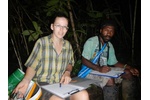
Katerina Sam and Bonny Koane...
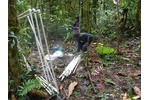
Cages from PVC pipes and netting
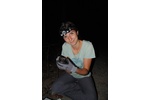
Elise Sivault releasing a bat
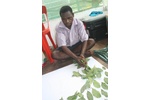
Listí pro analýzu býložravého...
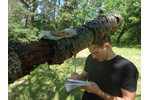
Survey of ant comunities
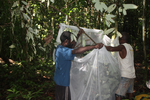
Arthrods being collected












